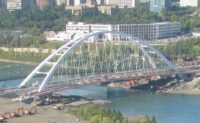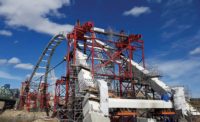Contractors building two key bridges in Edmonton are facing millions of dollars in late-completion penalties and the recent decision not to work on one of the bridges during winter will add to that project's delay.
City officials announced in late October that they would be shutting down construction over the winter on one of the bridges, a 100-m-long steel structure which spans a major artery in Edmonton. The news was particularly tough for the contractor, a part of Calgary-based Graham Group, which has been hit with penalties of $11,500 (C) a day since early October, when the new 102 Ave. Bridge was originally slated to open.
The project timetable began to unravel last spring, when bolted sections on several girders deflected during erection, bringing construction of the $32-million (C) project to a halt and triggering a third-party review by city officials.
Now that bridge is not expected to open until fall, 2016.
Late Arriving Walterdale Bridge Sections
Meanwhile, contractors building the city’s new $155-million (C) Walterdale Bridge over the North Saskatchewan River are grappling with their own major delay, with traffic not expected to flow across the structure until late 2016, roughly a year later than planned.
The prime contractor, the Acciona/Pacer Joint Venture, has been hit with $10,000-a-day penalties which will continue until the 206-m-long steel truss bridge opens. City officials have estimated the penalties could reach the $5-million mark before the bridge opens.
“There is no fine cap for the contractor,” wrote a spokeswoman for the city of Edmonton. The contract beween the city and Acciona/Pacer "transfers the risk of the delay to the contractor.”
Construction on the Walterdale Bridge ran into serious trouble when a South Korean steel fabricator for the sections of the bridge’s arches and deck fell months behind. When the remaining pieces to assemble the bridge’s central arch finally arrived during the past few months, it was too late to prevent the project from being pushed back a year.
It isn’t clear who is at fault for the delays.
That bridge’s 950-ton central arch will be floated on barges across the river in mid-November and kept in place by berms placed on either side of river. A pair of lift towers will raise the arch into position. In spring crews then will start putting the bridge deck into place.
Even so, some major pieces have yet to make it to Canada, including “some steel for the bridge deck and shared-use path,” wrote the city’s spokeswoman. “The deck pieces are being coated and prepared for shipping from South Korea.”
Works Suspended on 102nd Ave. Bridge
Graham Construction and AECOM, the prime contractor for the 102nd Avenue Bridge, will suspend work over the winter. Edmonton officials decided it was too unsafe to continue work during snow season.
A tent-like structure would have to be built over the bridge in order to warm it for construction to continue in the winter, the city’s chief engineer told the Canadian Broadcasting Corp. But that might have caused damage to the deck while posing a potential hazard to motorist driving on the highway below the bridge, according to the report.
The contractors had been scrambling to make up for lost time, with multiple shifts working extra hours on the bridge project, city officials noted in statement.
Construction came to a halt on the bridge this spring when three girders buckled as they were being installed, forcing the closure of the busy east/west highway corridor underneath.
The girders were repaired through “heat straightening.”
Two of the girders were in fairly good shape, having suffered from only an elastic deformation, said Paul Zubick, chief operating officer of Supreme Group. It’s Edmonton-based bridge division is performing the steel erection on the 102nd Ave. bridge.
The damage to the third was more significant, rising to a “plastic deformation,” with a kink in the top flange, Zubick said.
To repair the deformation, Supreme’s steel fabricators went to work, heating up the beam in the area of the deflection. The heat typically expands the girder in one direction, followed by cooling, which has it contract in the opposite direction, back into shape.
The beams were then inspected and reviewed before being brought back to the construction site.
A city report, released in July, also zeroed in on the perceived cause of the girders’ deflection, blaming it on mistakes allegedly made by Supreme in bracing made by the fabrication and erection. Barry Belcourt, Edmonton’s transportation construction director, told various media outlets that the city’s third-party investigation showed that too little permanent bracing was in place at the time of the deflection in March.
The subcontractor installing the steel beams misinterpreted “the precise bracing requirements between the last four girders,” claims a statement on the transportation department’s website.
On the release of the second-to-last girder, the spacing braces failed, causing lateral tortional buckling, city officials claim.
However, Supreme’s Zubick countered that the cause was still under review.
“It’s still in front of the insurance company, he said. “We have submitted some information.”




Post a comment to this article
Report Abusive Comment